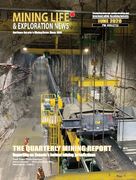EXPEDITED EXPLORATION PROGRAM IS AIM OF COBALT POWER GROUP

Cobalt Power Group Inc. intends to expedite its exploration program on its property near the Town of Cobalt in Northeastern Ontario.
The company has received the final report for the airborne geophysical survey recently completed over its Smith Cobalt Project. The survey was carried out by Eagle Geophysics, on time and on budget in November 2016.
The survey comprised 885-line kilometres of Quadrimag (an advanced 4-sensor magnetometer array) and VLF-EM. It was flown using 50-metre spaced north-south lines, with tie lines at 1 km spacing, draping the surface topography at an average elevation of 40 metres.
Based on an average speed of 110 km/h and a sampling frequency of 10 Hz, data samples were recorded at intervals of approximately 3 metres.
Results indicate that major structures in the project area exhibit a general spatial relationship to known mineralized veins in the region. This data will help the company develop the best exploration plan for the Smith Cobalt Project, including ground geophysics, mapping, and sampling, followed by target delineation and drilling.
Dr. Andreas Rompel, president and CEO comments: “We are delighted with the recent airborne geophysical survey. The results, combined with the upcoming IP data, will be crucially important in accurately defining drill targets.
This information helps accelerate the interpretation of the geology of the project, enabling us to drill in early spring. Moreover, the steady rise in cobalt prices from $11.00 to $16.75 USD over the past seven months (up to Jan. 31, 2017) encourages us to expedite our exploration of the Smith Cobalt Project.” Cobalt Power is a publicly traded Canadian exploration company listed on the TSX-Venture Exchange (TSX-V: CPO) focused on cobalt exploration and development.
The company has made a series of strategic property acquisitions over the past several months, seeking cobalt mineralization near Cobalt, a region with a long history of silver and associated cobalt production.
Property holdings total 720 ha (1780 acres) in contiguous blocks. There are several historic mining operations on the properties that are potentially accessible, including the Smith Cobalt shaft and its underground workings.
Survey Key Highlights:
- Numerous contact zones are clearly visible in the magnetic data defining a complex network of interwoven, regional formations. Structurally, the area is dominated by a major NW-SE striking fault, well defined in both the magnetic and VLF-EM data. This fault is accompanied by numerous additional, more local, faults throughout the area of the survey. In general, features of interest are subtle trends in the magnetic data that occur in proximity to regional contact zones.
- The survey identified several areas where geologic structures (from the magnetometer data) correlate with the presence of near-surface conductivity (from the VL-EM data). Such areas could represent the presence of sulphide mineralization within Five-Element (Ni-Co-As-Ag-Bi) Vein deposits.
- Of particular interest is the interpretation of magnetic lineaments showing a relationship between magnetic ridges (interpreted structures) and the location of historical known mineralized veins.
The Smith Cobalt Project is underlain by a sequence of Archaean volcanics which are uncomformably overlain by Huronian sediments. These formations have been intruded by the Proterozoic-age Nipissing diabase sill.
Faulting, on both a regional and local scale, has been found by surface mapping and in drill cores. Polymetallic veining, and especially pinkish-white carbonate veins, has also been reported.
Thus, all the necessary geological components of accepted mineralization models for cobalt-silver have been identified on the properties.

|